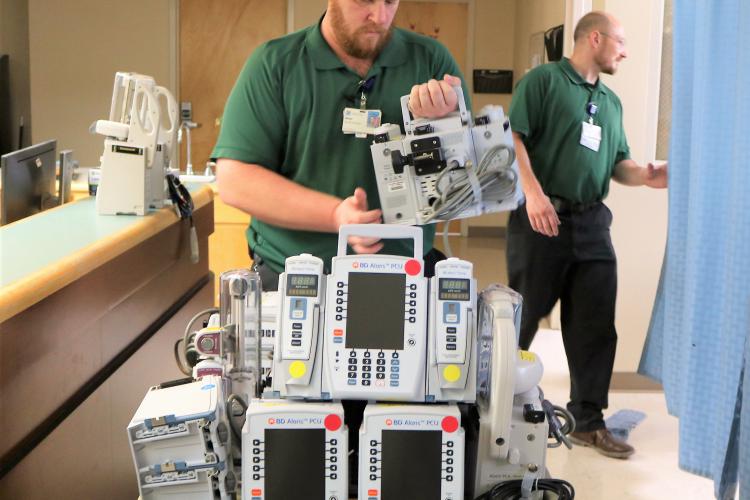
A small army of Clinical Engineering team members started at 6 a.m. Thursday with plans to replace more than 2,200 pieces of equipment scattered all over the JPS Health Network.
By the time the work day was over, the technicians replaced the infusion pump system in every department of the hospital where patients receive care.
Director of Clinical Engineering Josh Virnoche said the busy day -- during which his fitness calculator recorded more than 11,000 steps, more than five miles of walking – was well worth it because the new hardware will greatly enhance patient safety and hospital efficiency.
“The great thing about the new machines is that they will integrate with Epic,” the patient management system JPS uses, Virnoche said. The new pumps also have better, brighter screens that make it easier to read the information they display.
Infusion pumps are computer-controlled devices that intravenously deliver fluids including medicine, and liquid nutrients to the blood stream of patients.
Ann Bouras, Medication Safety Officer at JPS, said the installation of the pumps may have taken place in a one-day blitz, but the process of selecting them took months. As the old pumps reached the end of their life cycle, a multidisciplinary team was assembled to evaluate a replacement system on several factors including safety, ease of use, options available, compatibility with other systems and price. The candidates were whittled down to five and then again to three before the remaining vendors were asked to come in and give a demonstration of their products.
“Members of the team voted for the system they thought would bring the most benefits to JPS,” Bouras said. “The one we chose was the only one that met all of our criteria.”
Eliminating the need for nurses to manually enter information about the amount of medicine patients receive is a huge benefit, Bouras said. Nurses will still review programming before hitting the start button on the machines to administer prescriptions. But they won’t have to punch in long programming codes where a typo could make a critical difference.
Not only will Epic tell the equipment how quickly to pump medication into a patient’s blood stream, eliminating the possibility of human error that existed when the information was manually punched into the old equipment. Virnoche said the new system will also allow for more precise billing, accurately measuring and recording the amount of medicine patients receive.
Virnoche said the installation started in the operating rooms so they were ready to go before surgery started for the day, making sure there were no delays for patients. The work went so smoothly that the installation was completed about two hours sooner than originally planned. Currently, the old pumps are being prepared to be sent back to the manufacturer for credit toward the purchase of their replacements.
